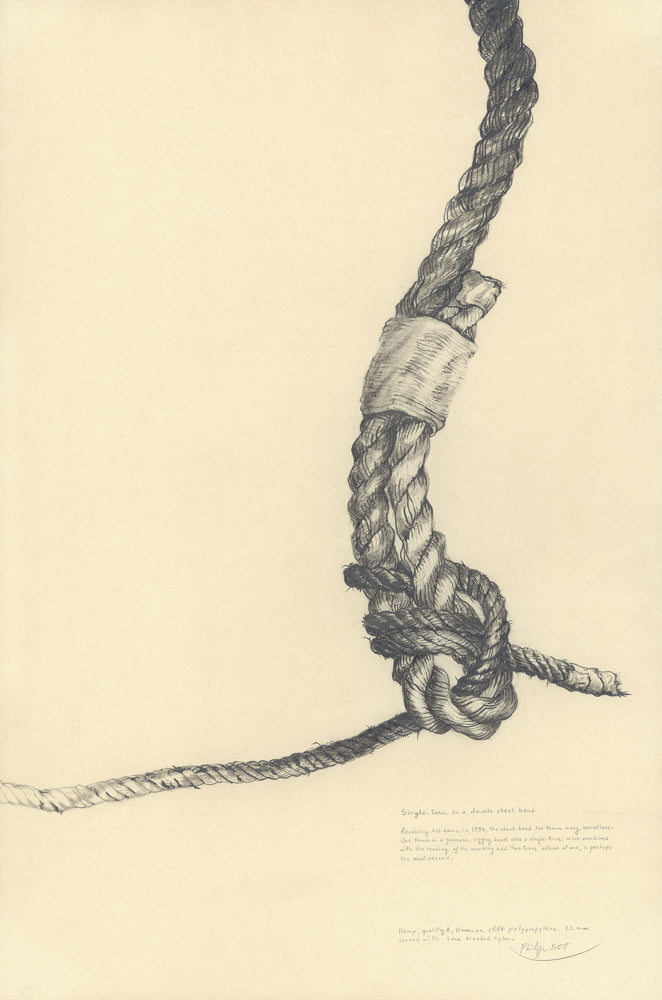
Philippe Petit
PHILIPPE PETIT

“How to Tie More than Sixty Ingenious, Useful, Beautiful, Life-Saving, Magical, Intriguing, and Secure Knots.” Maryann Yin
Philippe Petit walked the 200 foot Notre Dame towers in ‘71, the 300 foot Sydney Harbor bridge pylons in ‘73. He inclined 2,300 feet from the Palais de Chailot to the Eiffel Tower. His career as a tight rope walker spans from Jerusalem to Tokyo, from Grand Central Station in New York to the Citadel of Vauban in Belgium. What he’s best known for is his high wire walk above the World Trade Center in ‘74.
His years of planning and practicing, the clandestine ascent, the arcanum of complicated rigging and the performance itself have been well documented. But what gives Petit the big brassy ones to step into a chasm like the one between the Towers… on a wire… a strand… 17 thousand feet above the pavement crawling with little human specs? Where seagulls won’t even wing and no man goes without a flying machine? Knots.


Petit has mastered 200 of an estimated 4,000 varieties of knots — give or take — for similar riggings with different names. He began an eccentric career as a street performer, riding around the streets of Paris on a unicycle, juggling and picking pockets. If you’ve seen Man On Wire, the 2008 documentary, or read any interview with him, you’d feel in a snap his passion, if not a lunatic penchant for drama. And if literally taking your life in your hands when crafting a knot is not dramatic enough Petit, as part of an ardor for knots and cords (he invented the name “Cordia” for his daughter), for connections between places and things, has sketched thousands of directional illustrations in his book Why Knot (Abrams Image, New York 2013), and included a dozen beautifully detailed drawings of his favorite knots.
A knot is the rope, the turning over and around itself, changing its shape and texture through friction, strengthening it in this one spot or combining it with another. But if tied too tight it weakens the integrity of the material. If a rope is stretched to its limit it will usually break nearest the knot. Different materials are subject to unique effects from the elements. UV rays will make a nylon rope brittle, and humidity will shrink hemp. Tough luck if you’ve rigged a high wire contraption, hundreds-pound poles and all, and a quick storm passes by to rain on your carnival. Even the humectant specter of fog slipping past, soft and intangible, will make lines so tense they can pull the whole show down, pinging and popping as the sashes break.


How often do you think about knots? In the morning, running a comb through your hair, or on your sneakers… stringing them on or worse – untying their laces. Even then it’s a fleeting, cursory thought, or else with regret and annoyance. What sort of knot is on your shoes anyway but the most rudimentary, first conceived about 40,000 years ago. Move ahead a few millennia, when along the shores you see not only volleyball nets and woven towels, but also fishermen casting lures at the ends of monofilament. Ever try tying one of those while chanting: Bunny ears bunny ears, playing by a tree, criss-crossed each other trying to catch me? You realize then how poorly prepared your Nikes have left you.
Scores of knotting books have been published, many of which are riddled with mistakes. These mistakes can be traced back to the earliest knot-making book, pseudonymously published by Tom Bowling, whose illustrations were mirrored by the engravers. Hundreds of knots were printed backwards. This book, with all its erroneous illustrations, was considered the definitive guide on tying and subsequent books copied the mistakes in later tomes. With all the multitude of knots, the misnomers and redundancies, how can you tell the useful from the ornamental, the dependable from the unsound? It takes a man with skin in the game and years of brassy experience.


Add enough cotton fibers and you’ll get a string. Add enough strings, weaving them together, and you’ll get a canvas. Add enough rope, looping it, feeding it through, and you’ll get a knot. In the hands of Petit a knot moves from dependable safeguard to an object for itself. Then, with graphite on paper, it is removed from three dimensions and rendered into two. Whether a drawing of a knot is still a knot may be to Petit forgone. For him, a connection is a connection is a connection. In Why Knot we can feel his determination to entangle the reader, to make us “nutty for knots.” His prose animates the convoluted history of knot making. Hundreds of colorful illustrations guide us through the precise steps of creating them, from a simple square knot to the more eccentric Hangman’s noose, which has 13 turns, no more no less, to ensure the right amount of slip, to cinch tight and true to snap the neck and not the rope.
Perhaps no one has an archive as extensive as Petit’s. His 200-volume library contains books from how-to-guides to special interests, where knots are an oblique necessity; say for fishing, or climbing. In these editions, some rare and valuable (like an original Ashley Book Of Knots), some recondite and specialized, margins have been filled with comments, words deleted or added; faulty drawings are modified and marked for clarity. All this study, this measured sensibility has been reduced to 60 useful knots, with special attention to detail. The spine of Why Knot, for example, is designed to let the book lie flat allowing the reader to use both hands while practicing on the included red string. The margins are left wide for notes. Color-coding delivers clarity to what end goes over, and which end goes through. Petit has created “the perfect little book of knots,” essential if you’ve got the brassy ones to put yourself on the line.



